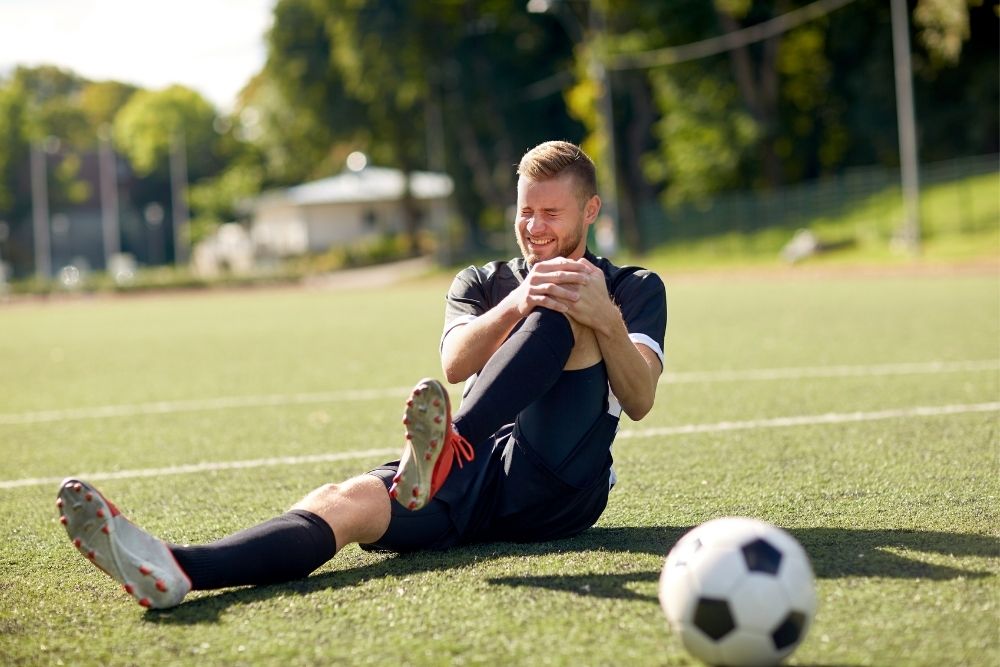Recently, there has been a lot of interest in soccer in the United States and more people are starting to engage in it more than before. Soccer is a good way to increase endurance, speed, and fitness while also enjoying the camaraderie of team sports.
It is often regarded as a relatively low-risk sport because it records injury rates that are one-fifth of those seen in American football.
Even though soccer is often considered to be safer than other sports, injuries can still occur. Injuries also occur in soccer because it is a fast-paced team sport that frequently involves attacks, falls, and collisions which can result in both horrid and mild injuries.
These injuries can range from small scrapes and bruises to catastrophic injuries requiring urgent medical attention. They can keep a soccer player out of play for some time—even permanently in some cases.

Although soccer injuries can occur in any part of the body, injuries to the limbs and lower parts of the body are often more frequent. Soccer players mostly sustain injuries to their knees, oftentimes to their meniscus, ranging from tears to nasty damage.
However, we know you may begin to wonder if you can play soccer with a torn meniscus. It will amaze you to know the level soccer players can push themselves even with torn meniscus injuries against all odds just to win a match.
Read on to decipher what a meniscus injury is, whether or not you can keep up with a torn meniscus in soccer, why or why not, and how to maintain your composure and performance even with a torn meniscus.
Quick Navigation
Can you play soccer with a torn meniscus?
No doubt, every soccer player wants to be exceptional, with astonishing skills and the ability to deliver outstanding performances. Nevertheless, the hope of achieving great success in this regard can be cut short by a torn knee meniscus.
Not every soccer player would want to quit an important match because of a torn meniscus. Some would want to keep on playing despite their injury which often leaves spectators wondering if soccer players are free to play with obvious injuries.
We believe it is possible to play sports with a meniscus tear. For example, an American football player playing for the Tennessee Titans was said to have played with a meniscus injury and wasn’t uncovered until the end of the game.
He played through the meniscus tear for several weeks. Can this happen on the soccer field? Some doctors would usually advise soccer players to avoid playing through the pain of a torn meniscus.

Dr. Eric S. Millstein (a board-certified orthopedic surgeon in Los Angeles California) warns against this practice, stating that a torn meniscus is a serious knee injury that can get complicated if not properly treated.
The meniscus, otherwise known as fibrocartilage, is a cartilage that is found between two bones, as in the case of the knee meniscus. It is a “half-moon shaped” or “C” shaped cartilage found between the tibia and femur which is the lower leg and the thigh.
The knee has a meniscus on its inside part called the medial meniscus, and a lateral meniscus found on the outside. Together, they make up the two menisci found in the knee.
The meniscus is avascular, as it does not have blood vessels inside, except for the edge that joins with the vascular lining of the knee, providing the outer part of the meniscus with blood supply. This is why it does not bleed when cut.
The meniscus functions as a cushion, providing room for smooth gliding between the tibia and femur. It also serves as a shock absorber, as it can absorb all the forces it is made to go through regularly.
Many soccer players who play through meniscus injuries might reconsider their actions if they completely understand how severe this injury can get when not properly handled.

When is a meniscus considered torn?
A meniscus can be torn or completely damaged after a direct collision usually caused by quick changes in direction and also careless twists or winding motions during a match.
Soccer players are often at risk of sustaining this injury when they get hit on the knee during matches or training. Changing directions or accidentally twisting their leg while landing on their feet after a jump can also cause a tear in the meniscus.
An injured or torn meniscus does not heal on its own due to its avascular nature (limited blood supply to it), except in cases where the tear is minimal. When a torn meniscus is not treated, it will degenerate into a damaged meniscus.
A damaged meniscus can cause an increase in the wear of bones (tibia and femur) since the cushion formerly supporting them has now become damaged. At this point, players may begin to experience great pain and may not be able to play soccer for some time, depending on the severity.
What are the symptoms of a torn meniscus?
- Fastening on the knee
- Swelling
- Pain
- Noticeable shakiness of the knee joints
- Difficulty in walking
- Inability to straighten the knee properly
- Mood swing

When can you play soccer with a torn meniscus?
A soccer player might have a meniscus tear during a soccer match without even noticing it, especially when the soccer game is at its peak with high expectations from all sides. This is usually when the tear in the meniscus is small and shows no noticeable symptoms.
Such a soccer player can still play but for a short while before the pain from the torn meniscus begins to manifest. Generally, a mildly torn meniscus can heal by itself without requiring any surgery or further medical attention.
If you are a soccer player with a mildly torn meniscus, you can continue playing while keeping vigilant of your injury. You can safely do this by making sure you avoid putting much strain and pressure on the affected knee throughout your training or match.
Nevertheless, if you can’t cope with such a condition, you would have to take a short break for the injury to properly heal itself. It usually takes a short period before you can fully resume play. Don’t hesitate to always seek professional help when needed.

When should I stop playing soccer with a torn meniscus?
Due to the lack of blood flow to over 70% of the entire meniscus, its tendency or ability to heal properly by itself is generally limited. A soccer player that continues to play soccer after showing symptoms of a torn meniscus risks tearing the meniscus more, causing further damage.
To know if you can play with a torn meniscus, you have to seek the advice of your medical doctor who will examine you properly before offering advice.
Your doctor should be the one to let you know if you can continue playing with a torn meniscus or desist from playing, depending on the severity of the injury.
In instances where surgery is needed to remove a floating piece or repair a damaged meniscus, you will have to stop playing soccer. You will be out of play for the duration of the treatment and its healing process.
How do you treat a torn meniscus?
While a few soccer players are sometimes fortunate enough to recover from a minor tear of the meniscus, a whole lot of others usually prefer seeing a doctor. If the symptoms of a torn meniscus persist after administering proper first aid, it is important to immediately seek medical attention.
Treating a torn meniscus can sometimes involve surgery in some cases to prevent the tear from further escalating. Some portions of the torn meniscus can sometimes lead to arthritis, thereby causing soccer players great pain.
In some special cases, surgical interventions are usually required to repair the damage or floating pieces of the torn meniscus. This is the best way to treat a torn or damaged meniscus since it hardly ever heals by itself due to the lack of blood flow to it.

Conclusion
Soccer is a game that involves a lot of twisting motions, medium contact, and jumping, to mention a few. Consequently, soccer players are always at risk of tearing their meniscus during soccer activities.
Even if you play soccer for leisure, play locally, or play it as a hobby, it is important to understand that you are not exempted from possible injuries such as tearing your meniscus or dislocating a joint.
You should pay close attention to your body, especially your knee for any sign or symptom of a torn meniscus. Seek proper medical attention if you start to notice any signs of an injury.
Playing soccer with a torn meniscus usually depends on your endurance level, and most importantly, your doctor’s recommendation. Do not hesitate to adhere to your doctor’s recommended treatment plan which will hasten your recovery period.
Whether it is surgery or taking a break from soccer, the waiting period is worth it. Staying physically fit should always be the priority of every soccer player.
Hi there, I’m Jay.
Soccer is everything in my life! My friends and I have created this blog with all our enthusiasm, passion, and understanding after years of playing pro soccer. Hope you will enjoy it!
